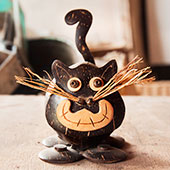Design Resource
Intricate Coconut Carving - Parra, Goa
Coconut Shell Craft
by
Prof. Bibhudutta Baral, Divyadarshan C. S. and Sandhya B.
The coconut shell is neatly taken out from the fibrous husk. The shell is cut into half and the fruit or the kernel is taken out neatly. The shell is sanded with three different files, the first one is used to roughly file out the fibrous roots, the second one helps file better to give a smooth finish and the last filing tool helps to give a finished and much smoother look to the coconut shell. Once the coconut shell is sanded it is ready to be glued to the base or it’s cut according to the design that the craftsman decides to make.
The making of coconut shell craft involves simple steps:
1. Collection of coconuts
2. Filing
3. Cutting
4. Polishing/varnish
5. Finishing
1. The Collection of Coconuts: The coconuts are collected of various sizes from places. The mature coconut is preferred because it is lignin hence there is no threat of germs attack. The immature coconut contains water and fruit and is cellulose. So the mature coconut is durable and preferable to work on.
2. Filing: The coconuts are collected the fibrous husk and kernel part is removed and cleaned to get only the shell. The shell is sanded with three kinds of filing tools until a smooth finish is obtained. Sanding with smaller grains of sandpaper gives a good finish to the surface.
3. Intricate Carving and Cutting: The coconut shells are sanded. They are cut into desired shapes and sizes required for an article to be made with a coping saw. The intricate cross work is done with the coping saw. The shape of the cross and the designs are marked on the coconut shell with a marker. With the help of a coping saw, it is cut along the line and the Cross-is obtained. The sides of the cut coconut piece are filed. The carving gauges are used to give intricate designs and cut the intricate designs.
4. Polishing: The cut coconut shells are stuck to the coconut shell base with adhesive (glue) and are given a coat of varnish (wood polish) to obtain a neat and glossy effect.
5. Finishing: Drilling holes in a pattern, carving on shells, fixing electric wires to coconut lamps, holes for buttons, and all the external furnishings are done. With all these furnishings done the products are ready to be packed. Items vary in weight between 100g to 200g approximately.














